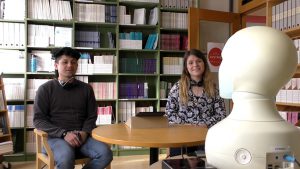
A recent study has suggested that robots can elicit a response by making eye contact even with people less likely to participate in discussions.
Researchers at KTH Royal Institute of Technology published results of experiments where robots led a Swedish word game with people with varied proficiencies in Nordic language. They discovered that gazing at the less proficient players, a robot can evoke participation from the most reluctant player.
According to doctoral students Sarah Gillet and Ronald Cumbal, the results show proof that robots could play an important role in an educational setting.
Gillet says calling on someone by their name is not always the best way to inspire engagement. ‘Gaze can by nature influence very dynamically how much people are participating, especially if there is this natural tendency for imbalance— due to the differences in language proficiency’, she says.
‘If someone is not inclined to participate for some reason, we showed that gaze is able to overcome this difference and help everyone to participate.’
Cumbal says that research has proven that robots can aid group discussion. However, this is the first study to observe what happens when a robot uses its gaze in an imbalanced group interaction— dominated by one or more individuals.
The experiment involved pairs of players where one was fluent in Swedish and the other was still learning it. The players were given instructions to give the robot clues in Swedish so it could point out the correct term. The robot’s face was an animated projection on a specially designed plastic mask.
It would be natural for a fluent speaker to dominate that scenario, according to Cumbal, the robot was able to elicit more participation from the less fluent player by redirecting its gaze to them and waiting for an attempt.
‘Robot gaze can modify group dynamics— what role people take in a situation,’ he says. ‘Our work builds on that and shows further that even when there is an imbalance in skills required for the activity, the gaze of a robot can still influence how the participants contribute.’
The study was published at the ACM/IEEE International Conference on Human-Robot Interaction ’21. It was nominated for the Best Paper Award at the conference. The research was funded by the Swedish Research Council, the Swedish Foundation for Strategic Research and the Jacobs Foundation.
By Marvellous Iwendi.
Source: KTH